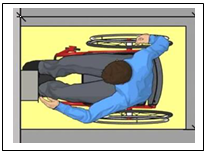| 1. |
Sufficient clear floor or ground space _____________ at accessible controls, operable parts, drinking fountains, lavatories and sinks, ATMs and fare machines, appliances, beds, and other elements. |
|
|
Is required |
|
|
Maybe required |
|
|
Is not required |
| 2. |
At most elements, clear floor or ground space can be positioned for either a forward or a side approach. For better usability, a forward approach is required at certain elements, including dining and work surfaces, drinking fountains, lavatories, and most sinks. At other elements, a side approach is allowed. A side approach is typically provided or required at sales and service counters, beds, and most appliances. |
|
|
True |
|
|
False |
| 3. |
Clear floor spaces must meet requirements for ground and floor surfaces, including criteria for firmness, stability, and slip resistance. They must be free of level changes and not slope more than |
|
|
1:48 |
|
|
1:30 |
|
|
1:15 |
| 4. |
The minimum size ____________ applies whether the space is positioned for forward or side approaches. Additional space is required when the space is confined on three sides and is obstructed for more than half the depth, such as when elements are recessed in alcoves.

|
|
|
30 X 48 |
|
|
12 X 30 |
| 5. |
Turning space ________ in these accessible rooms and spaces:
- toilet and bathing facilities
- dressing, fitting, and locker rooms
- transient lodging guest rooms
- dwelling units (all rooms on an accessible route)
- patient bedrooms
- holding and housing cells
- saunas and steam rooms
- raised courtroom stations served by ramps or lifts with entry ramps
- certain recreation spaces (amusement ride load/ unload areas, fishing piers and platforms, play components, and shooting facilities)
|
|
|
is not required |
|
|
is required |
| 6. |
Accessible floor and ground surfaces must be stable, firm, and slip resistant. Stable surfaces resist movement, while firm surfaces resist deformation by applied forces. Accessible surfaces remain unchanged by external forces, objects, or materials. |
|
|
True |
|
|
False |
| 7. |
Most loose materials, including gravel will not meet these requirements unless properly treated to provide sufficient surface integrity and resilience. Binders, consolidates, compaction, and grid forms may enable some of these materials to perform satisfactorily but require repeated maintenance. |
|
|
Will meet |
|
|
Will not meet |
| 8. |
Carpet that is thick, cushiony, or loose impairs accessibility, particularly wheelchair maneuvering. The standards specify the maximum pile height (1/2” measured to the backing, cushion, or pad) and texture (level or textured loop, level cut pile, or level cut/uncut pile) and require firm backing. Cushions or pads also must be firm or can be avoided to ensure greater firmness. |
|
|
True |
|
|
False |
| 9. |
Exposed edges must have trim on the entire length of the exposed edge and be fastened to the floor to prevent curling. Trim must meet specifications for changes in level, including requirements for beveled edges when the height exceeds ¼ inch. The maximum height ______. |
|
|
½ inch |
|
|
1 inch |
|
|
1.5 inch |
| 10. |
Changes in level can be up to __________________with a slope no steeper than 1:2. Changes in level above a ½" must be treated as a ramp or curb ramp (or a walkway if a slope no steeper than 1:20 can be achieved). These specifications apply to all portions of accessible routes, including thresholds and carpet trim. |
|
|
¼" without treatment or ½" if beveled |
|
|
1" without treatment or 2" if beveled |
|